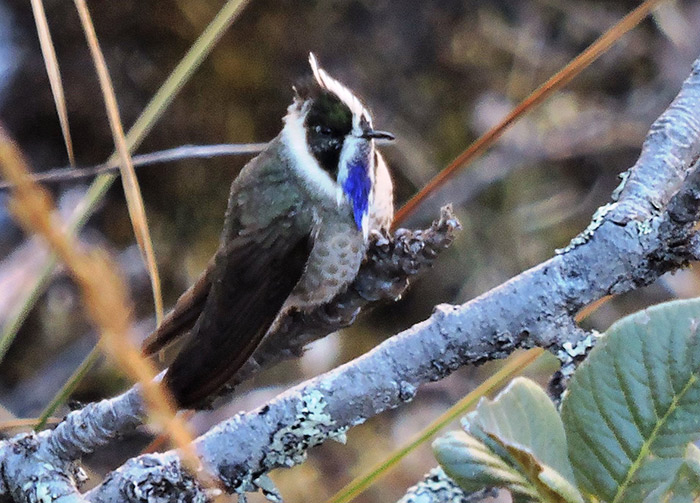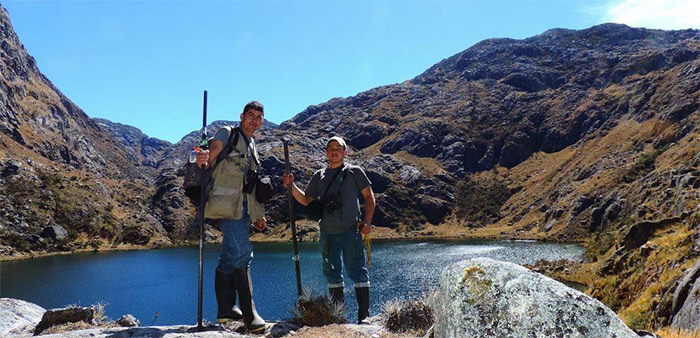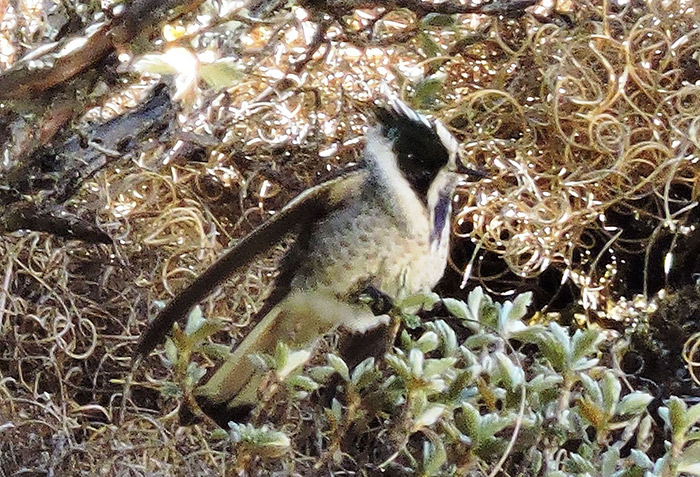Spectacular lost hummingbird rediscovered after 69 years
The Blue-bearded Helmetcrest, a hummingbird not seen for 69 years and thought to be extinct, has been re-found in Columbia and photographed for the very first time.

An intense and prolonged dry season in the Sierra Nevada de Santa Marta combined with fires set by Kogi indigenous people for agricultural purposes has devastated its fragile high-elevation habitat or known as páramo, home to a suite of endemic plants and animals.
Two conservationists Carlos Julio Rojas and Christian Vasquez who work at ProAves’ “El Dorado” nature reserve in the mountain range, carried out investigations to document the fires. On March 4th 2015, the photographed the spectacular Blue-bearded Helmetcrest – a hummingbird that was last seen in 1946 and feared quite possibly extinct. Unfortunately, the habitat of the three birds they saw is threatened by ongoing fires. A scientific article detailing the rediscovery was published today in the journal Conservación Colombiana and is available online at www.proaves.org with further photos.
Described in 1880, the charismatic Blue-bearded Helmetcrest (Oxypogon cyanolaemus) was last seen in 1946; thereafter, it disappeared. Restricted to the world’s highest coastal mountain range, the Sierra Nevada de Santa Marta (rising to over 19,000 feet), the Helmetcrest was suspected to be facing severe threats as cattle ranching by indigenous people expanded across the sensitive high-elevation slopes of the mountain range. Each dry season, more of the fragile brush and forest is burned to make way for grasslands for cattle. The fragile montane forests of the Santa Marta mountains are unique as this isolated mountain range pre-dates the Andes of South America by over 100 million years Over the past ten years, searches for the charismatic Blue-bearded Helmetcrest failed.
Last year it was pronounced “Critically Endangered” by IUCN and BirdLife International and considered perhaps to be extinct. The species is dependent on stunted forest and bushes amongst natural páramo grasslands – habitat that is highly susceptible to fires during the dry season. The situation is even more difficult because the flowering plant the Helmetcrest depends on – the Santa Marta Frailejon (Libanothamnus occultus) – is itself threatened by persistent fires and has also been declared Critically Endangered. In 2013, according to a WWF report thepáramo of the Sierra Nevada was being seriously affected by extensive cattle herds belonging to indigenous communities who repeatedly burn it for pasture.
The highest elevations of Sierra Nevada de Santa Marta were declared a National Park in 1964. Fifteen years later, in 1979, the park was declared a UNESCO Biosphere Reserve. Several indigenous reserves cover the mountain range, and some 50,000 indigenous people, mainly of the ethnic groups Kogi and Arhuacos, live in the area. In 2014, the journal Science published an article that identified the Sierra Nevada de Santa Marta National Park as the world’s most important protected area for the conservation of threatened terrestrial species – rated first across over 173,000 protected areas worldwide.
During a prolonged and particularly intense dry season in February 2015, National Park staff informed local conservationists Carlos Julio Rojas and Christian Vasquez, who work for Fundación ProAves at the El Dorado Nature Reserve in the Sierra Nevada de Santa Marta, of an ongoing crisis with fires set by indigenous peoples across the park. Seeking to document the environmental impacts of this burning, Carlos and Christian used their vacation time to explore the higher elevations of the mountain range and recorded multiple fires that were destroying fragile natural habitat.

At 11 AM on March 4th 2015 during surveys of the fire, Carlos Julio Rojas who lives in the Sierra Nevada excitedly noted: “I saw the flash of a bird screeching past me and saw it perch on a bush nearby. I managed to take a quick photo of it before it flew off. I then reviewed the photo on the camera screen and immediately recognized the strikingly patterned hummingbird as the long-lost Blue-bearded Helmetcrest – I was ecstatic!! After reports of searches by ornithologists failing to find this spectacular species, Christian and I were the first people alive to see it for real.”
Christian took up the story. “We set up camp and for the next two days watched the area to document a total of three individuals of the Helmetcrest in an area of less than 10 hectares [25 acres] with three scattered tiny patches of forest clinging to the steep hillsides and surrounded by the remains of burnt vegetation. And the area is really important as we also discovered the Critically Engendered Santa Marta Wren alongside the Helmetcrest.” “Sadly the survival of the Blue-bearded Helmetcrest hangs by a thread,” says Carlos Julio Rojas. “The impacts of fire are everywhere with the charred remains of plants littered across the páramo. I spoke with the Arhuacos indigenous peoples, and they told me that the Kogi peoples are setting the fires and running pigs and cattle across the area. It is crucial that the fires are stopped immediately and that cattle and pigs are removed from the highest elevations to allow the fragile páramo ecosystem to recover before this unique hummingbird and its equally rare foodplant become extinct.”

A scientific article detailing the discovery was published today in the journal Conservación Colombiana and is available online at www.proaves.org.
Over one million inhabitants in the dry, arid lowlands around the Sierra Nevada depend on the filtration and provision of water from its páramo ecosystems. Further degradation of the páramo for livestock production not only endangers the survival of the Helmetcrest, but could also result in future severe droughts impacting over a million people in the region.
Hopefully, Colombian conservation entities, the National Parks authority, and the Kogi indigenous peoples can work together with Fundación ProAves to better protect the future of the Sierra Nevada de Santa Marta – the planet’s most irreplaceable mountain for both people and biodiversity.
ProAves
18 March 2015



